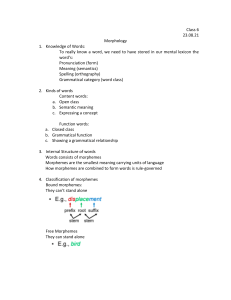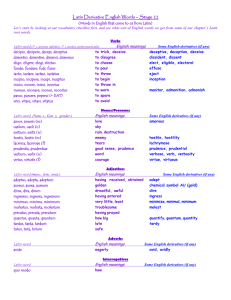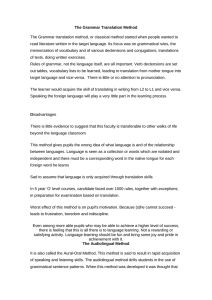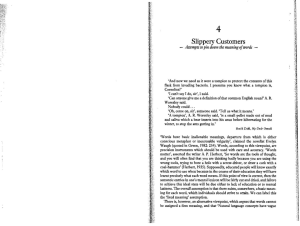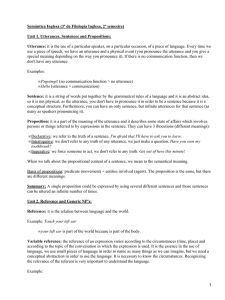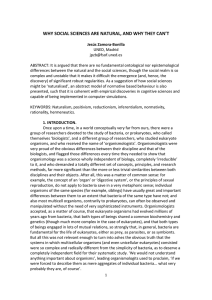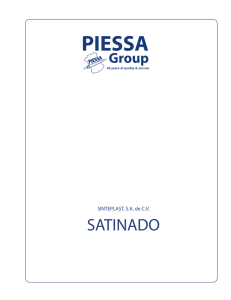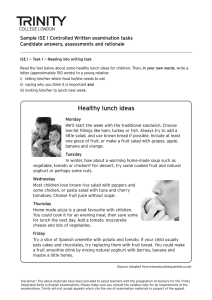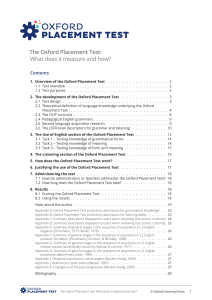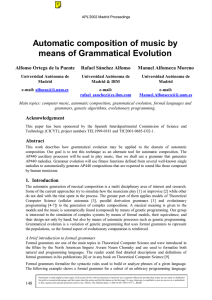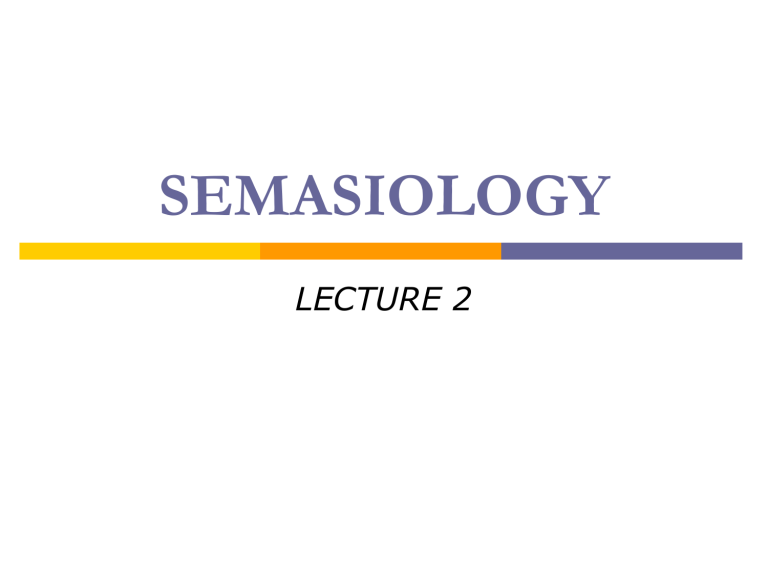
SEMASIOLOGY LECTURE 2 SEMASIOLOGY 1. Approaches to Analysing Meaning. 1.1. Referential Approach To Meaning; 1.2. Functional Approach To Meaning; 1.3. Operational Approach To Meaning. 2. 3. Types of Meaning of Words. Two Approaches to the Content Facet Units. SEMASIOLOGY is an area of Lexicology that is devoted to the study of meaning. There is no universally accepted definition of meaning. However there are 3 main categories of definitions of meaning, which may be referred to - referential approach; - functional approach; - operational approach. 1.1. Referential Approach 1. 2. 3. 3 components connected with meaning: The sound-form of the linguistic sigh; The concept underlying the sound-form; The referent – the part of aspect of reality to which the linguistic sign refers. The referential model of meaning – basic triangle concept sound-form referent In what way does the meaning correlate with each element of the triangle and in what relation does it stand to each other? 1. The sound-form of the word [fW] is not identical with the meaning of the word fir, because sound-forms of words in different languages are different, but express the same meaning: e.g. English [fW], Russian [‘jOlkq]. 2. The meaning of the word is closely connected with the underlying concept, but it is not identical with it. Concept is the thought of an object. The meanings of words are different in different languages. concept ‘a building for human ‘fixed residence of habitation’ family or household’ English house home Russian дом дом language One object can be denoted by some words of different meanings: In speech the referent of can be denoted by the word cat, animal, pussy, Jerry, pet, etc. All these words have the same referent, but different meanings. CONCLUSION: The meaning is not to be identical with any of the three points of the triangle, but is closely connected with them. 3. 1.2. Functional Approach Principle: The meaning of a linguistic unit can be studied only through its relation to other linguistic units. It is based on analysis of various contexts. Arrive at, in. Arrival early, late, sudden, of etc. They occupy different positions in relation to other words. Distribution of the word – position of a word in relation to other words. Context – the minimum stretch of speech necessary and sufficient to determine which of the possible meanings of a polysemantic word is used. 1.3. Operational Approach Principle: defining meaning through its role in the process of communication. Ann arrived at 6 o’clock. It may imply: Ann was some hours late or Failed to keep her promise or She was punctual as usual. CONCLUSION: The implication depends on the concrete situation of communication. Meaning – the direct information conveyed by the units consisting the sentence; Sense – the information added to the extralinguistic situation. II. Types of meaning of Words The grammatical meaning – an expression of relationship between words in speech. G.m. is the component of meaning recurrent in identical sets of individual forms of words: the tense meaning: went, played, saw, broke, spent.. the case meaning: boy’s, children’s, brother’s… the meaning of plurality: toys, books, joys, girls… 1. The lexical meaning – the meaning proper to the given linguistic unit in all its forms and distributions: go, went, gone, going – the same semantic component ‘the process of movement’, but different grammatical meanings (tense, person, number). The lexical and grammatical meaning cannot exist without each other. сведения – plural information – singular are not semantically identical. 2. The part-of-speech meaning expresses the reference to a certain class of words. Major word-classes: nouns, verbs, adjectives, adverbs; Minor word-classes: articles, prepositions, conjunctions… 3. All members of a major word-class share a distinguishing semantic component as a lexical one of a part-of-speech meaning: nouns have the meaning of thingness or substantiality, though they possess different grammatical meanings of number and case. The grammatical aspect of part-of-speech meaning is conveyed as a rule by a set of forms: number tabletables and case boy – boy’s. III. Two Approaches to the Content Facet Units 1. Semasiological –starts with the name (form) and consists in considering different meanings of the word, determining interrelations between them, as well as discovering semantic relations between different words. 2. Onomasiological – starts from the object and consists in analyzing different words correlated with it. This approach helps to discover how meaning is formed, considering its basic properties and peculiarities. The semasiological approach (polysemy) Meaning Object The onomasiological approach (synonymy) Semasiological Approach to Meaning (Polysemy) word LSV1 1. colour; LSV2 2. not ready to be eaten; LSV3 LSV4 green 3. not experienced; 4. made of green leaves of vegetables green salad Onomasiological Approach to Meaning (Synonymy) Object (indication) Word 1 Word 2 Word 3 Word 4 ILL 1. sick 2. unwell 3. unhealthy 4. ailing
